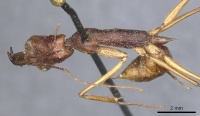Odontomachus philippinus
| Odontomachus philippinus | |
|---|---|

| |
| Scientific classification | |
| Kingdom: | Animalia |
| Phylum: | Arthropoda |
| Class: | Insecta |
| Order: | Hymenoptera |
| Family: | Formicidae |
| Subfamily: | Ponerinae |
| Tribe: | Ponerini |
| Genus: | Odontomachus |
| Species: | O. philippinus |
| Binomial name | |
| Odontomachus philippinus Emery, 1893 | |
Odontomachus philippinus was found only in shaded, humid places in degraded primary forests or in secondary forests. This species is greatly endangered by the destruction of forests in the western Visayas region. (Sorger & Zettel 2011)
Identification
Sorger & Zettel (2011) - Odontomachus philippinus is closely related to Odontomachus scifictus; it differs in mesopleuron sculpture and petiolar shape (see key and notes of O. scifictus for additional details).
Keys including this Species
Distribution
Sorger & Zettel (2011) - Endemic to the Philippines and there restricted to the western Visayas islands of Panay, Negros and Siquijor. Natural occurrence in Central Luzon (Manila) (Emery 1893) is doubtful. (see the nomenclature section below for details regarding the originally reported type locality).
Latitudinal Distribution Pattern
Latitudinal Range: 15.583333° to 15.583333°.
| North Temperate |
North Subtropical |
Tropical | South Subtropical |
South Temperate |
- Source: AntMaps
Distribution based on Regional Taxon Lists
Indo-Australian Region: Philippines (type locality).
Distribution based on AntMaps
Distribution based on AntWeb specimens
Check data from AntWeb
Countries Occupied
| Number of countries occupied by this species based on AntWiki Regional Taxon Lists. In general, fewer countries occupied indicates a narrower range, while more countries indicates a more widespread species. |

|
Estimated Abundance
| Relative abundance based on number of AntMaps records per species (this species within the purple bar). Fewer records (to the left) indicates a less abundant/encountered species while more records (to the right) indicates more abundant/encountered species. |

|
Biology
Castes
Nomenclature
The following information is derived from Barry Bolton's Online Catalogue of the Ants of the World.
- philippinus. Odontomachus papuanus r. philippinus Emery, 1893e: 203 (in text) (w.) PHILIPPINES (Luzon I.).
- Type-material: holotype worker.
- Type-locality: Philippines: Manila (no collector’s name).
- Type-depository: MSNG.
- Subspecies of papuanus: Emery, 1911d: 113; Wheeler, W.M. & Chapman, 1925: 71; Chapman & Capco, 1951: 45; Baltazar, 1966: 239.
- Junior synonym of infandus: Brown, 1976a: 104; Bolton, 1995b: 297.
- Status as species: Sorger & Zettel, 2011: 153 (redescription).
- Distribution: Philippines (Negros, Panay, Siquijor).
Unless otherwise noted the text for the remainder of this section is reported from the publication that includes the original description.
Sorger & Zettel (2011) - Emery (1893) describes Odontomachus philippinus as a race of O. papuanus, a species from New Guinea. He writes “provenient de Manille et m'a été envoyée par M. Mayr” [translated: origins from Manila and sent to me by Mr. Mayr]. A single worker in the Museum Genoa is the holotype. There are two further workers in the Natural History Museum Vienna which origin from Mayr's Collection and bear a label with Mayr's notes “papuanus var. m. gestreiften Seitengruben det. G. Mayr” [translated: papuanus variation with striped side grooves] [on head]. These specimens bear locality labels “Manilla Heer.” and “Manilla Forel.”, respectively. Both Heer and Forel were collectors, but like Mayr they never reached Asia. We assume that all three specimens are from the same series, but that their provenience from the city of Manila is doubtful or – more unlikely – after human transportation. According to newly collected material, which agrees very well with the holotype, O. philippinus occurs only in the Western Visayas. Its native occurrence in Central Luzon, the best sampled area in the Philippines, is very unlikely.
Description
Worker
Sorger & Zettel (2011) - Worker with smallest HW: CI 68, HL 3.03, HW 2.07, MdI 62, MdL 1.88, MsL 4.70, SI 152, SL 3.13, PnW 1.22, PtH 1.22, PtL 1.36, PtW 0.44, TL 13.19; worker with largest HW: CI 72, HL 3.63, HW 2.60, MdI 57, MdL 2.07, MsL 4.80, PnW 1.57, PtH 1.54, PtL 1.68, PtW 0.54, SI 138, SL 3.60, TL 15.63.
Structures: Striation on head extending from frontal lobes to ocular ridge, rest of head smooth and shiny. Pronotum with relatively coarse transversely oriented striation, in dorsal view no loops visible (loops may be visible in lateral view); posterolateral parts without striation, smooth and shiny. Mesopleuron smooth and shiny, along meso-metapleural suture a few faint striae may occur dorsally or ventrally, but at its middle always smooth and shiny. Petiole S-shaped, strongly bent backwards, convex dorsally. Entire ant appearing very shiny / glossy.
Pilosity: Pubescence sparse, short.
Colour: Uniformly dark; slightly reddish brown in specimens from Siquijor.
Type Material
Sorger & Zettel (2011) - worker; Museo Civico di Storia Naturale, Genoa) from "Manilla, Mayr".
References
- Brown, W. L., Jr. 1976c. Contributions toward a reclassification of the Formicidae. Part VI. Ponerinae, tribe Ponerini, subtribe Odontomachiti. Section A. Introduction, subtribal characters. Genus Odontomachus. Stud. Entomol. 19:67-171. (page 104, Junior synonym of infandus)
- Emery, C. 1893g. Formicides de l'Archipel Malais. Rev. Suisse Zool. 1:187-229. (page 203, worker described)
- Sorger, D.M. and H. Zettel. 2011. On the ants (Hymenoptera: Formicidae) of the Philippine Islands: V. The genus Odontomachus LATREILLE, 1804. Myrmecological News. 14:141-163.
References based on Global Ant Biodiversity Informatics
- Emery C. 1893. Formicides de l'Archipel Malais. Revue Suisse de Zoologie 1: 187-229.
- Emery C. 1911. Hymenoptera. Fam. Formicidae. Subfam. Ponerinae. Genera Insectorum 118: 1-125.
- General D. M., and G. D. Alpert. 2012. A synoptic review of the ant genera (Hymenoptera, Formicidae) of the Philippines. Zookeys 200: 1-111.
- Sorger, D.M. and H. Zettel. 2011. On the ants (Hymenoptera: Formicidae) of the Philippine Islands: V. The genus Odontomachus LATREILLE, 1804. Myrmecological News. 14:141-163.

